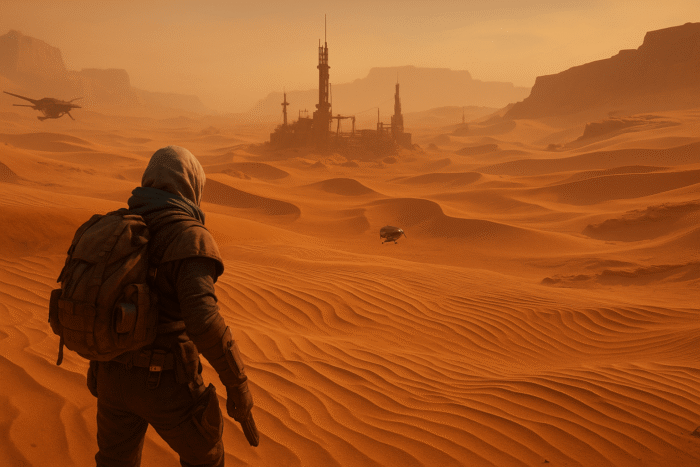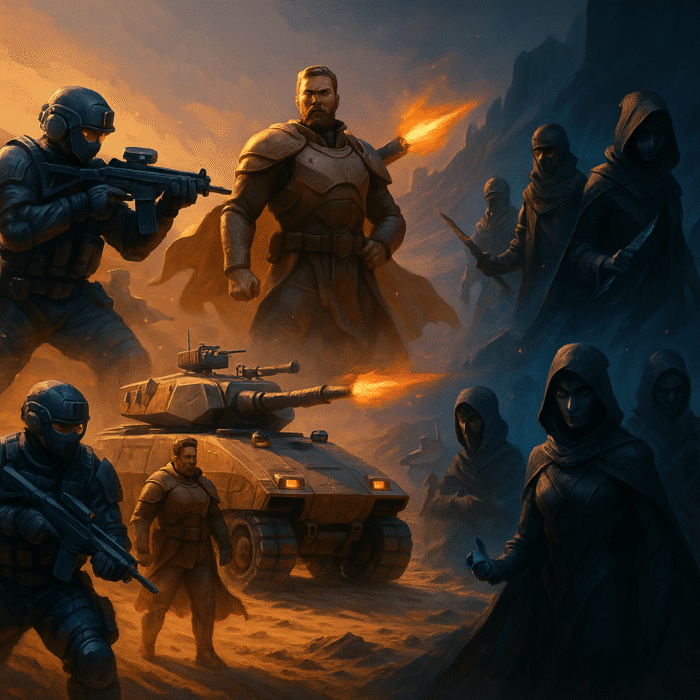Everything You Need to Know Before Starting Dune: Awakening in 2025
By Alex@PC╺
- PS4
- PS5
- XBox One
- Series X
- PC
Thinking about diving into Dune: Awakening, but not sure what to expect? With its ruthless desert survival mechanics, real-time MMO dynamics, and the ever-present threat of colossal sandworms, Arrakis isn’t a place for the unprepared. Whether you’re new to survival MMOs or returning from titles like Rust or Conan Exiles, Dune: Awakening demands strategy, speed — and a little insider knowledge.

This guide breaks down everything you need to know before starting Dune: Awakening in 2025 — from factions and gear to combat, progression paths, and time-saving tips. We’ll even touch on tools like boosting services that can give you a serious head start without spending 50+ hours grinding through early-game challenges.
Let’s gear up and survive the sands — the smart way.
What is Dune: Awakening?
At its core, Dune: Awakening is an ambitious survival MMO set on the harsh desert world of Arrakis — famously known from Frank Herbert’s Dune universe. Developed by Funcom, the game combines open-world exploration, base-building, real-time combat, and faction warfare in a sandbox where your decisions shape your survival and standing.
Players can roam vast deserts in search of spice, craft survival gear from salvaged tech, and build shelters to avoid lethal sandstorms or the iconic sandworms that stalk careless movement.
Unlike traditional MMOs, Dune: Awakening blurs PvE and PvP by allowing players to fight for control over spice-rich territories, craft vehicles, and trade goods in a fully player-driven economy.
Key features include:
- Persistent open world with real-time weather and day-night cycles.
- Deep character customization and skill trees.
- Faction alignment and political intrigue.
- Vehicle crafting and transport management — from bikes to ornithopters.
Whether you’re in it for the lore, the clan warfare, or the thrill of desert survival, this game offers a unique blend of tactical gameplay and resource risk management.

Minimum Requirements & Recommended Hardware
Before stepping foot onto Arrakis, it’s important to make sure your system is battle-ready. Dune: Awakening isn’t just visually stunning — its massive open-world and dynamic weather system can put a serious load on your hardware.
As of 2025, here are the latest official specs from Funcom’s Steam listing:
🖥 Minimum System Requirements:
- OS: Windows 10 (64-bit)
- Processor: Intel Core i5-8400 / AMD Ryzen 5 1600
- Memory: 16 GB RAM
- Graphics: NVIDIA GeForce GTX 1060 / AMD Radeon RX 580
- DirectX: Version 12
- Storage: 70 GB available space
🚀 Recommended for Smooth Performance:
- Processor: Intel Core i7-9700K / AMD Ryzen 7 3700X
- Graphics: NVIDIA RTX 3060 Ti or higher
- SSD: Strongly recommended for faster loading and texture streaming
Because Dune: Awakening features large-scale multiplayer zones and weather effects like sandstorms that affect visibility and particle rendering, weaker machines may experience stuttering or dropped frames in high-activity areas. This is especially critical during PvP raids or spice zone clashes, where seconds matter.
If you’re unsure how your rig compares, you can run a compatibility check using Can You RUN It to benchmark your performance against the game’s latest build.

Choosing the Right Starting Faction
In Dune: Awakening, your faction isn’t just a cosmetic label — it directly influences your gameplay style, alliances, and access to resources. Choosing the right one from the start can save you countless hours of backtracking, gear re-farming, and lost spice runs.
As of 2025, the game introduces several core factions, each with distinct philosophies and advantages. While the developers haven’t revealed every detail yet, early test builds and lore insights from the official Dune Wiki suggest a structure rooted in political power, desert survival, and spice control.
Here’s a breakdown of the major faction types likely to define your journey:
The Atreides Loyalists
- Ideal for: Players who prefer tactical coordination and structured teamplay.
- Strengths: Strong early-game defense, diplomacy buffs, resource sharing.
- Weaknesses: Slower solo progression, dependence on alliances.
The Fremen Clans
- Ideal for: Survivalists and stealth-focused players.
- Strengths: Superior terrain knowledge, faster spice harvesting, worm evasion perks.
- Weaknesses: Limited access to tech-based gear; reliant on desert skills.
The Smugglers & Independents
- Ideal for: Traders, solo players, and opportunists.
- Strengths: Flexible playstyles, access to black-market gear, profit potential.
- Weaknesses: Minimal faction support during PvP; exposed in open zones.
Common Mistakes When Picking a Faction
- Choosing by lore alone: What sounds cool in the books might not suit your actual playstyle.
- Ignoring clan dynamics: Some factions lean heavily on group synergy. Solo players may find them underwhelming.
- Assuming balance: In early access MMOs, factions aren’t always equally tuned — some may dominate the meta.
How Progression Works (And What Slows You Down)?
Progression in Dune: Awakening is layered, nonlinear, and often punishing — especially for players unfamiliar with the mix of survival crafting and MMO scaling. You’ll need to manage not just gear and XP, but also your character’s exposure, spice addiction levels, and faction reputation.
The game abandons traditional leveling in favor of tech tree unlocks, modular gear crafting, and territorial influence. This makes your growth path highly customizable but also easy to misstep without guidance.
Core Progression Systems:
- Skill Specializations: Combat, Survival, Engineering, and Trade routes that unlock perks and gear tiers.
- Spice Harvesting: Essential for progression but tied to risk-heavy zones patrolled by sandworms and PvP raiders.
- Crafting Infrastructure: You’ll need workbenches, power grids, and safe hubs just to maintain basic item flow.
- Faction Quests: Unlock exclusive perks and storylines — but often require group coordination or multi-hour runs.
Where Most Players Lose Time
- Wandering without clear objectives: The game doesn’t hold your hand. Without a plan, it’s easy to waste hours scavenging junk gear.
- Travel inefficiency: Until you unlock reliable vehicles, crossing zones takes real-time commitment — often ending in death.
- Lack of PvP readiness: Many jump into combat zones under-geared, losing progress and resources instantly.
Interestingly, Dune: Awakening is intentionally built with high entry friction to reward mastery and preparation — one reason it’s being seen as a contender for the next major MMO hit. For a broader look at these design choices, check this analysis on why Dune Awakening might be the next big thing.
How to Accelerate Your Progress?
If you’re a casual player or someone jumping in mid-meta, your best bet is to leverage boosts, faction carry runs, or direct progression packages. These give you:
- Access to higher-tier equipment faster
- Safezone escorting and spice farming runs
- Reduced grind time on key unlocks (workshops, PvP gear)
⚡ Instead of spending 30+ hours unlocking mid-game mobility and build options, services like Dune Awakening Boosting Service help you get straight to the action — especially if you’re joining friends already deep into the grind.
Combat and PvP: What to Expect Early On
Dune: Awakening doesn’t ease you into combat — it throws you into an ecosystem where gear, positioning, and preparation matter just as much as reflexes. PvP and PvE aren’t separated by strict zones, and even your first spice run can quickly turn into a live ambush if you’re not careful.
Unlike typical MMOs with target-lock systems, Dune features real-time directional combat. That means you’ll be aiming, dodging, and timing abilities — much closer to Rust or Escape from Tarkov than World of Warcraft.
Core Combat Features
- Directional Damage & Hitboxes: Positioning matters — headshots do more damage, and flanking can give you the edge.
- Modular Weapon System: Weapons can be modified with scope types, damage modules, and faction-specific tech.
- Gear Tiers: Your combat viability is tightly linked to what you’re wearing. Crafting or unlocking Tier 2+ armor makes a major difference.
- Sandworm Interference: In some zones, combat vibrations can attract worms mid-fight, adding unpredictable chaos.
PvP in the Early Game: Brutal But Avoidable
Early PvP encounters are often one-sided. More experienced players or premade groups will dominate open spice fields and desert routes. Unless you’re running with a clan or fully equipped, it’s best to avoid:
- Highly trafficked spice zones
- Trading hubs during peak hours
- Long-range travel without a vehicle or escort
The upside? You can minimize risk by farming in off-hour windows, avoiding predictable routes, or using lightweight escape gear like the starter ornithopter — if you’ve unlocked it.
Dune: Awakening isn’t your average MMO — it’s a layered survival experience that demands forethought, adaptability, and a keen sense of risk management. From choosing the right faction and navigating complex progression trees to surviving brutal PvP encounters and managing spice runs, every choice on Arrakis matters.
By understanding the systems before you log in, preparing your hardware, and planning your playstyle, you’ll avoid the most common pitfalls that frustrate new players.
With the right start, you can enjoy everything Dune: Awakening has to offer — from epic clan wars to solo desert expeditions — and thrive in one of the most unique and punishing sandbox MMOs released in recent years.
